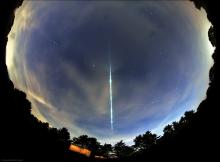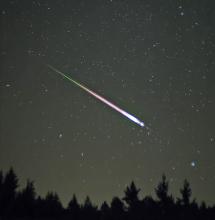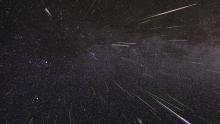Listen to today's episode of StarDate on the web the same day it airs in high-quality streaming audio without any extra ads or announcements. Choose a $8 one-month pass, or listen every day for a year for just $30.
You are here
Moon and More
The crescent Moon starts the night off right, with a beautiful encounter with two planets. It then keeps the good skywatching going by setting around 9 or 10 o’clock — making way for the year’s first meteor shower.
As the color of twilight begins to drain from the sky, look for the planet Venus to the lower right of the Moon, and Mars to the upper left. Venus is the brilliant “evening star,” so it really stands out. Mars is only about one percent as bright, but it’s also closer to the Moon, so you shouldn’t have any trouble finding it. It looks like a fairly bright orange star.
Moonset clears the way for the Quadrantid meteor shower. It’s named for the extinct contellation Quadrans Muralis, which represented an early astronomical instrument. Today, that region of the sky lies within the borders of Bootes, the herdsman. It climbs into good view in the wee hours of the morning, marked by its brightest star, Arcturus. You don’t have to look at Bootes to see the shower, though — its meteors can shoot across any part of the sky.
The shower is one of the shortest of all — its peak lasts just a few hours. But the Quadrantids can produce dozens of meteors every hour during that peak, so the shower is a good one to watch.
To do so, find a dark, safe viewing site far from the glow of city lights. Then bundle up against the winter chill, look up, and enjoy the show.
We’ll have more about the Moon and its planetary companions tomorrow.
Script by Damond Benningfield






